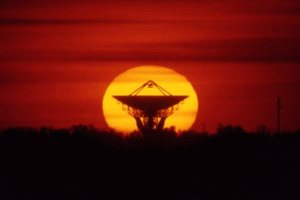Solar Physics and Space Climatology
Research Group
*For the complete team, see the respective websites

In the context of solar atmosphere monitoring activities with INAF radio telescopes, this research group is developing innovative techniques to obtain solar images at high radio frequencies up to 100 GHz. Since 2018, we have been monitoring the solar atmosphere in the 18-26 GHz band, obtaining weekly images of the Sun, and aiming to cover the entire solar cycle in perspective.
After the initial test campaigns aimed at defining and optimizing parameters for solar observation modes with INAF radio telescopes, the system is now ready for systematic monitoring of the Sun that allows us to obtain: (1) accurate measurements of the brightness temperature of the “quiet Sun” components, which have been little explored at our frequencies and are very important for characterizing the solar atmosphere (density, temperature, etc.); (2) characterization of the flux density, spectral properties, and long-term evolution of dynamic phenomena of the solar disk (such as active regions and coronal holes); (3) prediction of powerful solar flares (and consequent geomagnetic storms) through radio band detection of particular spectral variations in active regions, a fundamental tool for space weather and related aerospace and terrestrial safety issues (see https://sites.google.com/inaf.it/sundish for more details).
New challenges and technological and scientific milestones are expected with the prospect of new instrumentation available up to 100 GHz. In particular, our new solar observation system at high radio frequencies has recently been approved as a permanent observatory in Antarctica (Solaris project: https://sites.google.com/inaf.it/solaris). This system combines the implementation of new interchangeable receivers suitable for solar observations installed on small radio telescopes available in our laboratories, in the Alps, and in polar regions. Operations in Antarctica will offer unique observational conditions (ideal atmospheric opacity and solar exposures for about 20 hours a day) and unprecedented monitoring in the 70-120 GHz band. This will allow for continuous monitoring of the chromosphere, identification, and spectral analysis of active regions before, after, and during solar flares.
The Solaris observatory will be the only infrastructure in the world that can offer continuous solar monitoring at 100 GHz, and will allow us to acquire and disseminate solar data and images in synergy with national and international networks for space weather.
External links
| SunDish project website (solar observations with large INAF radio telescopes) |
| Solaris program website (Solar observatory in Antarctica and international network) |
Latest updates
| Date | Description |
| 2024-05-31 | https://www.media.inaf.it/2024/05/31/sole-nelle-onde-radio/ |
| 2022-07-15 | https://www.media.inaf.it/2022/07/15/progetto-sundish/ |
| 2018-03-16 | https://www.media.inaf.it/2018/03/16/radioastronomia-sole-medicina/ |